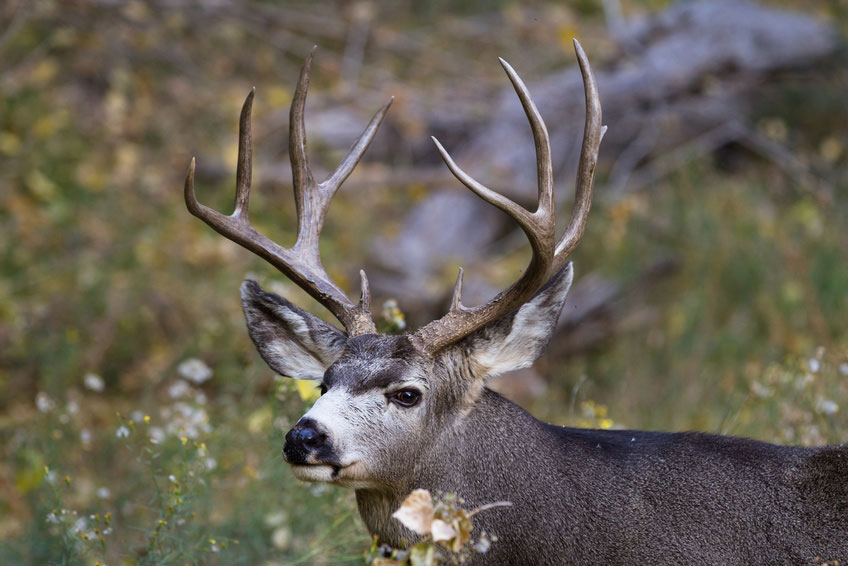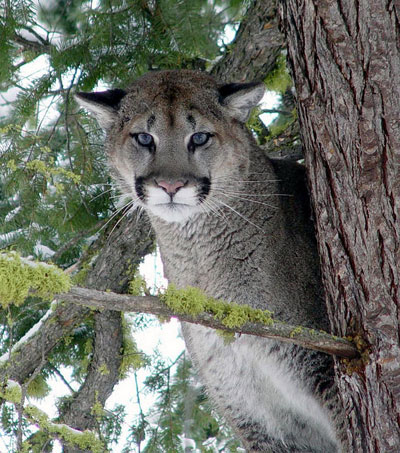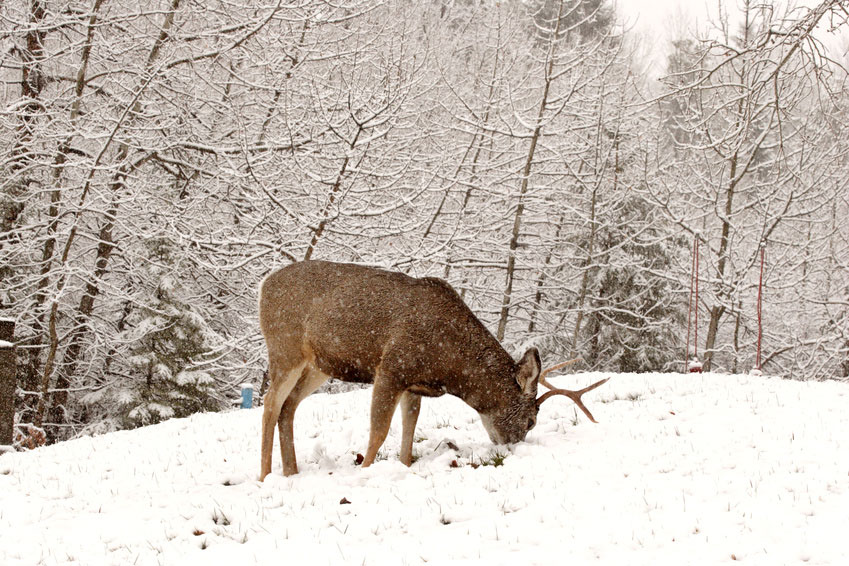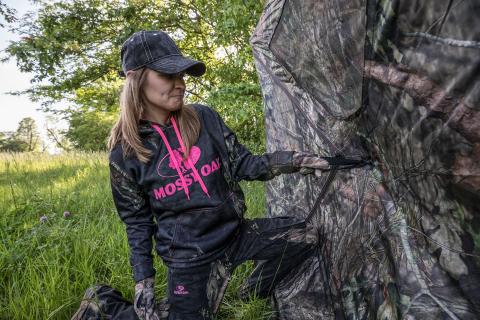Longtime, avid hunter Marshall Johnson of Bismarck, North Dakota, a Mossy Oak ProStaffer, is the senior regional director for the Mule Deer Foundation that restores, improves and protects mule deer habitat, including land and easement acquisitions, and develops programs that help mule deer and black-tailed deer conservation.

Mule deer and black-tailed deer live throughout western North America from the coastal islands of Alaska down the West Coast to southern Baja, Mexico, and from the northern border of the Mexican state of Zacatecas, up through the Great Plains to the Canadian provinces of Saskatchewan, Alberta, British Columbia and the southern Yukon Territory. Mule deer are browsers with a majority of their diet being weeds and leaves and twigs of woody shrubs. They grow 3 to 3-1/2 feet tall and generally weigh 130-280 pounds, have a 310-degree view around themselves due to their eyes being located on the sides of their heads, can detect movement up to 1900+ feet away, and have a sense of smell 1,000 times stronger than a human’s.
In the past couple of years, we’ve seen improvements in America’s mule deer herd. All across the mule deer range, we’ll have pockets where the mule deer are doing fairly well, and also there will be pockets where the mule deer aren’t doing so well. The reason for this is that weather is the number-one culprit impacting mule deer populations. Especially in the Northwest, weather is the number-one killer of mule deer and other wildlife. If you look at a typical year with good summers, and the mule deer have fed up and have a good layer of fat on them, you would think they could sustain heavy snowfalls. However, when you add in the rut, many of those mule deer bucks get beat up bad, fighting one another. But those bucks usually live until March, although they may be in a bad condition. If we get a really tough blizzard in later March, that seems to be when the most mule deer fatalities occur.
Many people believe that heavy winter snows cause the most mule deer fatalities. However, the late winter snows have the most devastating effects on most of the mule deer herds in the West. In North Dakota and eastern Montana, in 2010-2012, we had three horrific winter snows, and those states lost about 75 percent of their mule deer herds during that time. Those winters went from November to deep in March. Fortunately, North Dakota’s Game and Fish Department did an excellent job of managing their mule deer herds and helping the herds to rebuild by limiting the number of tags that were given out to bring the number of mule deer in the herds back up. I went to quite a few meetings that our Department of Game and Fish had with hunters and heard numbers of hunters say, “Let us put our guns away for a few years, if that will help the population of mule deer get back to where it needs to be. We still can hunt pheasants, grouse and geese.”
In North Dakota and South Dakota, we’re seeing about a 25 percent increase in the number of tags being allotted for harvesting mule deer. For the 2018 mule deer season, I’m projecting a pretty good season throughout the West. But I did mention that are pockets where the mule deer population is still struggling, for instance in central and eastern Washington. Those places were hit very hard by wildfires two years ago, but those herds are starting to rebuild. Overall, throughout the mule deer range, I feel we’ve had a good year of mule deer reproduction due to adequate rain. Here in the Dakotas where I live, bowhunters already are sending in photos of some nice trophy mule deer that have been taken. I’m very excited about these early results.
The Effects Wolves Have Had on Mule Deer Populations
 When you take a look, nationally, at all the predators that feed on mule deer, the mountain lion /our-obsession/blogs/hunting/treeing-a-mountain-lion and the coyote are the two predators that seem to be taking the most mule deer, more so than the wolves. The wolves’ primary diet seems to be elk. Yes, wolves do take mule deer, but they seem to prefer elk. And, yes, there are certain pockets like those in the Bitterroot Mountains up near the Canadian border where you’ll see that wolves have impacted the mule deer there. However, those wolves in that area have been there for quite some time.
When you take a look, nationally, at all the predators that feed on mule deer, the mountain lion /our-obsession/blogs/hunting/treeing-a-mountain-lion and the coyote are the two predators that seem to be taking the most mule deer, more so than the wolves. The wolves’ primary diet seems to be elk. Yes, wolves do take mule deer, but they seem to prefer elk. And, yes, there are certain pockets like those in the Bitterroot Mountains up near the Canadian border where you’ll see that wolves have impacted the mule deer there. However, those wolves in that area have been there for quite some time.
In western North Dakota, Montana, Wyoming, Colorado and Idaho, there are certain places where the populations of mountain lions are fairly high. Mountain lions will do some damage to a mule deer herd. The coyotes seem to affect the mule deer herd primarily during the fawning season in May and June. However, if our section of the U.S. has winters with heavy snows, all predators will catch and eat mule deer due to the mule deer not being able to escape as easily as when there’s not that much snow on the ground. That’s when we start seeing photos being sent in of three or four coyotes that have pushed a mule deer out on the ice and attacked it. Or the mule deer may be stuck in a ditch during periods of heavy snow.
Predictions for the 2018 Mule Deer Season
Archery season for mule deer has already started in some states in mid-September. In the Dakotas, archery season generally begins the first of September. Bowhunters have already sent in a number of reports of taking some nice muley bucks and also seeing good numbers of both mule deer and whitetails. Last year, winter started out very harsh, and many outdoorsmen were very concerned about the status of the mule deer herds. But during January 2018, the weather seemed to mellow out in the Dakotas. Those areas even had unseasonably warm temperatures during January and February, resulting in good recruitment of the mule deer herd.
Mule deer territory had a good weather year in 2017. When there are two or three years of mild winters and plenty of rain in the summertime, the mule deer tend to grow bigger antlers and have heavier body weights. Too, the overall health of all the mule deer is much better. These factors are what make me think that the 2018 season will be a really good year for mule deer hunting, especially for the Dakotas, Montana and Colorado.
Although bow season in the Dakotas and Montana is only a few weeks old at the time of this writing in mid-September, I’ve probably already seen some mule deer bucks that would score more than 200 inches each than in some time. In the Dakotas specifically, I’m seeing numbers of bucks taken by bowhunters that will score in the 170s, and a few pushing 180+ and 190+ points.
I don’t get real crazy about the size of a mule deer’s antlers. For me, a mule deer hunt is about the hunt, the adventure of the hunt and the anticipation of seeing different critters. I think we often forget that the experience is the trophy /our-obsession/blogs/hunting/hunting-for-adventure and taking an animal is the bonus. For me, a great stalk and a good shot – those are my trophies.
I didn’t draw a bull mule deer tag this year, but I did draw a cow mule deer tag. I had a medical issue with my eye, so I had to learn to shoot left-handed. Last year was the first year I’d ever shot a rifle left-handed. I was excited because with only one shot last year, I took an antelope and a mule deer buck, a nice big 3-pointer, after making a one-time, 335-yard shot in gusting winds with no shooting sticks while shooting left-handed. I was very happy about both of those hunts last year because all my life I’d hunted right-handed. Being able to take those two animals the first year I hunted left-handed was very exciting for me, especially with that long shot I took on my mule deer buck. That mule deer buck was an average-sized buck, but for me he was a trophy, due to my shooting left-handed and at that range and in those wind conditions.
I typically take mule deer at 100-150 yards. But unfortunately due to the drainage I was in, I couldn’t get any closer to the mule deer buck than 335 yards. I was shooting a Browning BAR .300 Win Mag Safari with a 180-grain bullet. Many hunters may think that a .300 is overgunning a mule deer, however, I also was hunting elk at the same time. If I’m just hunting mule deer, I usually shoot a Tikka .270 with 150-grain bullets. In many states, you can buy a tag that allows you to take an elk and/or a mule deer. In Montana when I still was a resident there, I could buy a tag like that over the counter. In many states, even if you have to draw for a combination tag and you’re not hunting in a trophy area, you may get that tag after applying for only 1-2 years.
The Mule Deer Foundation’s Purposes and Plans

I’m often asked what the Mule Deer Foundation does. The simple answer is that we raise money for the conservation of mule deer and their habitat. But actually, that’s an oversimplification about why the Mule Deer Foundation exists and what it does. We’re very fortunate because 88 percent of the funds we raise are used for our mission. We fund projects like native grass seedings, shrub seedings and plantings. We work with Game and Fish Departments and enforcement divisions helping to buy robotic decoys to catch poachers and fund mule deer studies to get GPS collars for mule deer to learn more about what mule deer do, where they do it, and when they do it. We also work with the U.S. Forest Service and the Bureau of Land Management to pull out old fencing on public lands, help in conifer reduction, conduct prescribed burns and do anything else we can to improve and increase habitat for mule deer. Whatever programs and organizations that the Mule Deer Foundation works with that helps mule deer also helps a wide variety of other wildlife.
We have a youth program, called M.U.L.E.Y. that stands for Mindful, Understanding, Legal, Ethical Youth. This program actually was started here in Bismarck, North Dakota, and is now our national program. We use this program to help introduce young people to all the shooting sports, including shooting rifles, archery, shotguns, pellet guns and handguns. We have programs that teach children how to use compasses and how to track deer after the shot using a blood trail. Since the compass is an old form of navigation, in the future, we’ll be teaching young people how to use hand-held GPS receivers and cell phones as GPS receivers. We help transition the young people with whom we work into 4-H shooting programs and high school shooting programs. We also help fund 4-H shooting programs and Archery in the Schools programs.
However, most of our funds go toward improving the mule deer’s habitat. Here in North Dakota, we have been doing a tremendous amount of work removing old fences on public lands. Any time we can pull out old, dilapidated fencing, we’re helping all the wildlife that live on that public land.






























